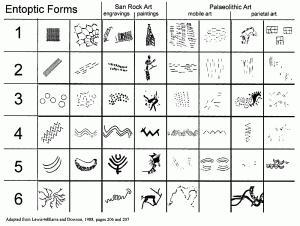In a collaborative (subscription seeking) arrangement with the Paris Review, Slate has just published a long piece on “America’s Ancient Cave Art” by John Jeremiah Sullivan. Many of these caves have been only recently discovered and their locations are largely secret. Except for a small group of Southeastern archaeologists, the existence of these caves and their contents have largely escaped public notice.
While I was vaguely aware of these caves, I don’t think I really understood — until after reading Sullivan’s article (the full version of which you can find here), how truly spectacular these finds are. It is exciting to know that America has many caves, with more being discovered, that contain deep “dark zone” passages filled with art that is just as spectacular and enigmatic as the Paleolithic caves in Europe and Mayan caves in Central America. Because the cave artists used river cane torches to light the passages and chambers, cave usage can be carbon dated. Some of the art in these caves is 6,000 years old!
As might be expected, cave usage apparently intensified with the rise of the mound building Mississippian cultures and the Southeastern Ceremonial Complex. I would be surprised if this did not result in cave art palimpsests with date ranges spanning thousands of years. Some of the more recent art dates from the late 1500s, shortly after Europeans had made contact with local tribes such as the Cherokee and Natchez, both of whom surely had historical connections to the earlier mound building cultures (such as Adena and Hopewell).
If we consider the massive time depth of dark zone cave art, from over 30,000 years ago until a few hundred years ago, and the fact it is found throughout the world, the signal we are getting is strong: caves have tremendous cosmological significance. They have been used by ritual specialists or seekers from both hunting-gathering and agricultural societies for tens of thousands of years for what appear to be quite similar purposes.
Moreover, many of the images found in such caves is consistent across time and space. Look at these 4,00 year old images from Appalachian caves and note their resemblance to San Rock art from Africa and much older Paleolithic symbolism from Europe:

While visiting one of the “Unknown Caves” with University of Tennessee anthropologist Jan Simek, Sullivan approached this kind of experience:
The tunnels got lower, narrower. Our faces were inches from the cave walls. We encountered weird paddlehanded creatures with long wavy arms. I began to feel that I was inside a hallucination, not that I was hallucinating myself—I was working very hard, in that cramped space, to write down Jan’s few cryptic remarks—but that I was experiencing someone else’s dream, which had been engineered for me, or rather not for me but for some other, very different people to progress through. It may have been shamanic. There’s a spring in that cave, Simek said, that can start to sound like voices, after you’ve been in there for a while.
Shamanic indeed.

